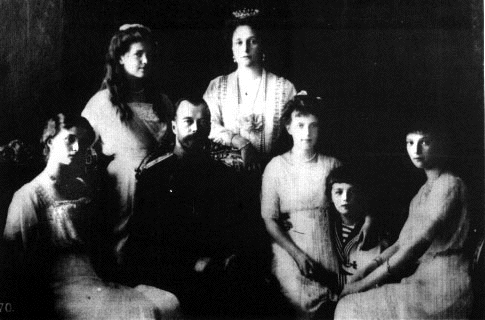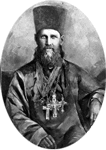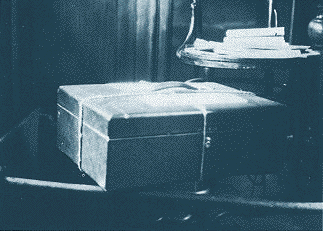

Letter from Metropolitan Vitaly
to the Vice-President of the Russian Federation
Concerning the Murder of the Russian Royal Family
Dear Yury Feodorovitch,
The consul of the Russian Federal government in New York has delivered your letter to me. It covers three points to which I consider it my duty to reply as Primate of the Russian Orthodox Church Outside Russia.
You write of your government's concern to clarify who was historically responsible for this terrible tragedy - the murder of the Royal Family, and you correctly evaluate this evil deed as a criminal act. Now there is definitely a responsibility, not just towards the Russian people, but towards people all over the world, to resolve this. To this end it is necessary to go back to the chronology of events in 1917 and 1918, and consider on what new laws the new Soviet Bolshevik government was based after the fall of the monarchy and what laws formed the basis of its activities. It is immediately obvious to any unbiased historian that Lenin himself was beyond any doubt the one who issued the orders, provided the inspiration and had complete control of all its activities. It is utterly inconceivable that in that evil and terrible time anyone could dare to do anything at variance with the hypnotic will of Lenin, who had unofficially become the dictator of the whole Bolshevik party. Consequently Lenin was the real murderer of the whole Royal Family and of those who voluntarily shared their fate.
This should be declared throughout the land of Russia, and his unfortunate remains should be buried in the place where he himself asked his terrible henchmen to bury him in his will (Editor's note: next to his mother!) . His corpse has been kept quite long enough as a disgrace to the whole of Russia in the Red Square of our ancient capital.
The second question is concerning our view of the "supposed" remains of the Royal Family. More than forty years ago we held a very solemn funeral in absentia for all the Royal Martyrs in the church built as a memorial to them in Brussels. Later we glorified them as saints together with all the New Martyrs of Russia. So for us, historically speaking, one more very terrible page in the history of our country has irrevocably been turned. Spiritually, the Royal Martyrs are always alive for us, and we ask for their holy prayers before the throne of God both for us, who are still living in this vale of tears, and for our harrowed, defiled and unhappy country. Only from the Lord do we await, if it should be His holy will, that He will miraculously reveal to us their holy relics, or whatever is left of them. We do not expect anything at all from anyone else.
Finally, the small reliquary containing a few fragments of the Royal relics, which were given to us by Sokoloff's commission of investigation, is kept in the Memorial Church in Brussels as a sacred object and so we cannot, and would not dare to, hand it over to any commission.
Please be assured, Yury Feodorovitch, of our very best wishes for the historical investigation which you have undertaken.
[Signed]
Metropolitan Vitaly
Interview first appeared in the Moscow journal "Radonezh" (1998 No. 1) and was reprinted in "Pravoslavnaya Rus" ("Orthodox Russia") 1998 No.3.
Vladika, we would like to ask you about the holy objects in the church of St. Job the Much Suffering in Belgium. It is said that they include a fragment of relics of the Holy Royal Martyrs, which was brought out of Russia in the past by N.A. Sokoloff, who conducted the investigation into their deaths. Is this correct?
"As I recall, there was a little finger which was attributed to the Empress. Then there were a few more small fragments, but everything was sealed into the walls of the church. So they are not on the altar table and you cannot venerate them. They were all sealed in when the foundation of the church was laid. There are icons and other things that belonged to the Tsar, but the relics themselves, such as they were (there were extremely small amounts) were all embedded into the walls. We cannot demolish the walls and start looking for them. That would be out of the question! I was present at the consecration of the church. At first these relics were kept in Brussels, in a small house church, but we kept them secretly, because there were still relatives of the Romanoff family alive who could have laid claim to them. But when they had all died and there was no direct lawful heir to the throne left, then we embedded these relics in the wall of the church."
Vladika, we would like to ask what you think about the "Ekaterinburg remains." We are constantly being told that these are the remains of the Royal Family.
"I would say that this is a question exclusively for the Church of Christ. And the Church of Christ awaits the time when it will be pleasing to the Lord to reveal these relics. Such was the case with St. Artemius of Verkola. He was a young man who looked after cows, and he was killed by lightening. The simple peasants thought that he had been killed by lightening though the will of God for his great sins - as a punishment. So they dug a grave and buried him on the spot, where he had been killed. Years passed, and suddenly one night everyone could see a bright light shining around that place. The old people began to recollect that this was the same spot where the young man's corpse had been buried. They told the local bishop, and he saw it for himself. He saw the light standing there like a pillar. The next day he gathered all of his clergy and they went there in a solemn procession, with banners, crosses and wearing their vestments, and when they reached the place, they opened the grave. They found that the relics of the young man were incorrupt. And many decades had passed since his death."This is what we are waiting for now. I think that the Lord will reveal these relics in a miraculous fashion. I think that over the whole of Siberia there will be hundreds of such fiery pillars, rising up to heaven from the relics of the Russian New Martyrs. Those who are nameless and unknown, who perished in camps, thrown into common graves. Then there will be a triumph, a real triumph of Orthodoxy in Russia. That is what I think.
"So we await this. But we cannot expect any discoveries from the secular authorities, and still less from former Soviet policemen. This idea borders on blasphemy. We held the funeral of the martyrs in absentia in the Memorial Church in Brussels, then we glorified them as saints, we pray to them, and we await the day when the Lord will miraculously reveal their relics to us. This is what we will believe. We await this only from the Lord, and not from anyone else.
"All this commotion - forgive me for calling it that - which has been going on for nearly twenty years now is just to pull the wool over our eyes, nothing more. These fables are quite unworthy of belief. This is what I think.
"One more fact to take into account is the testimony of our holy father St. John of Kronstadt, who had a vision. Of course, people "with both feet firmly planted on the ground" don't believe in such things. But we believe in them. The Tsar appeared and said, "Do not seek my remains!" [See "Revelation in a dream of Father John of Kronstadt" in "Journey to Saratov", Moscow, 1993]. This is what the Tsar said to Father John of Kronstadt. For us, believers, this is a very serious fact, although it is not so for people who make examinations with magnifying glasses and who knows what else, with these scientific and pseudo-scientific theories. Science tells us that a corpse can be identified beyond doubt as to whether it is a man or a woman. Its age can also be determined exactly. But to state that this corpse is Maria, that one Nicholas and a third one Anastasia is something which cannot be - cannot be done with any certainty. That is the verdict of scientific expert opinion." Metropolitan Vitaly

"We know, and this has been irrefutably proved by the investigator Sokoloff, that the bodies of the members of the Royal Family were chopped into pieces, and the blood soaked mass of human remains - arms, legs and torsos - was soaked in kerosene and acid and set on fire."
"Only from the Lord can we expect, if it should be pleasing to His holy will, that He will miraculously reveal their holy relics to us, or whatever is left of them, and I am convinced that such a spiritual triumph will definitely take place in Russia. "
"Vozvrashchenie" Issue No. 11, St. Petersburg, 1998.
The Duma's public hearings on the problem of the "Ekaterinburg Remains" requested the attorney general of the Russian Federation to continue the investigation into the circumstances surrounding the death of the Royal Family, and to involve independent counsel and major scientific experts from within Russia and the Russian Diaspora. In the opinion of those participating in the hearings, the work of the State Commission investigating the Remains "was extremely biased and non-objective and was clearly oriented towards simply confirming that the Remains were beyond doubt those of the Royal Family."
The group of experts came to the conclusion that "the results of the legal investigation into the murder of the Imperial Family conducted between 1918 and 1924 had been totally ignored," and the investigations of 1991 to 1998 "had been conducted in flagrant contravention of proper procedures." The State Commission had been unable to come to any decision on the identification of the remains, as this had been prevented by the judicial authorities. The decision to bury the Remains had created an extraordinary legal precedent: the investigation of the crime was incomplete, but the material evidence was nevertheless about to be buried.
The resolution of the public hearings, addressed to the President and government of the Russian Federation, stated that the burial of unidentified remains in the Imperial mausoleum in St. Petersburg would result in the creation of pseudo-relics, which would not lead to reconciliation and concord, but inevitably bring about divisions and an opposition movement. This would also cause irreparable damage to the reputation of the Russian Orthodox Church and its hierarchy.
ITAR-TASS
"Vertograd-Inform" No. 6(39), Moscow - St. Petersburg, June 1998, p. 20.
|
....There had already been a superficial inquiry into the night at the house of Ipatiev and those ensuing days by the Ganina mine on the tract of the "Four Brothers". But the task did need someone of Sokolov's acuteness and obsessive persistence. In the spring of 1919 General Dieteriches, acting for the 'Supreme Regent' Admiral Kolchak, had shown to him all relics that had been recovered from the house itself and elsewhere in Ekaterinburg, and from the debris at the place of cremation.... Still, nothing was so dramatic as the evidence that accumulated by the mine at the 'Four Brothers', a clay-surface tract-clay thrown up when the mine was being worked- in the woods a few miles from Lake Isetsk; furrowed soil, one open shaft, water brimming in the disused workings. Here, with Sokolov, Robert Wilton (of The Times), and others, Gibbes ( the royal family's tutor, ED.) stood on a summer day in his cloth cap and belted overcoat, imagining what had happened in the bleakness lit by the flare of those funeral pyres. The mine had long been abandoned. After the murders, and the Bolsheviks' retreat from Ekaterinburg, there were immediate discoveries. Peasants of a tiny village, Koptyaki, seeking to know what Red soldiers had been doing, had found, close to a shaft, the remnants of a large bonfire. Such things were scattered about as corset whalebones, braces buckles, slippers, dress fasteners, and a cross with green stones (the Empresses emerald pectoral cross).... After several months, a difficult gap, it took the deductive and scientific skills of Sokolov to reconstruct, beyond reasonable doubt, the posthumous fate of the Imperial Family of Russia. To this obscure loneliness the bodies had been borne through the dark; there, upon the clay area by the mine, they had been stripped, ruthlessly dissected, consumed by bonfires- one by the shaft, one near a birch tree- and then dissolved with sulfuric acid. Cinders and objects that remained unburned were thrown into the mine. Ice at the foot of the shaft had been smashed; when everything had sunk to the bottom of the water a false floor was let down and anchored. It was directly under the floor that Sokolov's searchers found the corpse of a small dog preserved by the ice, its right front paw broken and a hole in its skull.
|
Investigators at the Four brothers came upon bullets, a human finger from a middle-aged woman (long, slender, well-shaped, like Alexandra's hand), two pieces of human skin, and some pieces of human bone. A set of artificial teeth, discovered near the shaft, was identified as Dr. Botkin's. When Sokolov did not know what to make of a mixed collection, bits of lead foil, four nails, a used revolver bullet, and two small copper coins, gibbes recalled that Alexis had collected odds and ends and would go around in Tobolsk picking up old nails that 'one day' would be useful. So in a sense they were... The single-minded Sokolov, who had stayed at the tract of the Four Brothers until the twelfth hour- when indeed Red patrols were approaching the mine- had reached eastern Siberia with his boxes and dossiers. He was entirely persuaded that responsibility for the murder rested with both the Moscow Soviet and direct German pressure behind it. Now his persistent inquiries were endangering him in this confused country alive with cloak and dagger work and in the ebb of a failing war. But he had to preserve his material. During the British High Commission's halt at Verkhne Udinsk, the veteran White leader, General Michael Dieterichs, who had been with Sokolov at the mine wrote to Miles Lampton:
His Excellency the British High Commissioner,
To the last possible moment I wished to retain in my own hands and in Russia, in the revival of which I still continue to trust, the affair of the Imperial Family, i.e. the substantive evidence in the matter and the Remains of the Their Imperial Majesties, which it has been possible to find on the place where their Corpses were burnt.
The turn which events are taking, however, shows that in order to ensure the safety of these Sacred Relics (Caps in original, ED.), it is essential that They should not be connected with my fate.
I cannot leave Russia; the German orientation in Chita [further east in Siberia] may compel me temporarily to seek refuge in the forest. Under such conditions I am of course unable to carry with me the Great National Sacred Relics.
I have decided to entrust you, as the Representative of Great Britain, with the safe-keeping of these Sacred Objects. I think you will understand without my having to explain, why I wish it to be Great Britain: you and we have one common historical foe, and the tortuous murder of the Members of the Imperial Family, a deed unprecedented in history, is the deed of this foe, aided by their assistants the Bolsheviks.
I should like to add that if circumstances compel you to take the Imperial Remains and the documents out of Russia, and if in England cannot return them to me, I consider that they can be only handed over to the Grand Duke Nicholas Nicolaievich or General [A.L.] Denikin [commander of the whites in S. Russia].
Allow me to wish you and your country every prosperity, firmly to withstand the storm raging in the whole world at present.
I take the liberty of respectfully wishing all prosperity and health to His Majesty, the King of England, and beg to remain,
Yours very sincerely,
M. Dieterichs
7 January, 1920
A scribbled pencil note identifies the contents of the box:
This box, which once belonged to Her Majesty the Empress, now contains all that was recovered at the mine shaft from the remains of the burned bodies of:
His Imperial Majesty Nicholas II, Her Imperial [space left here for the titles] and burned together with them: Doctor Eugene Sergeyevich Botkin, Servant Alexi Yegorovich Trupp, Cook Ivan Mikhailovich Kharitonov, and girl servant Anna Stepanova Demidova.
Signed... Lt-General Dieteriches
5 January,1920

"The most savage crime of the century has been followed by the most cynical fraud of a funeral"
|
However, the commentary is not. One wonders why the translator has even bothered with an obscure and virtually unknown work such as this which he obviously has great contempt for, and is not shy in his stating this fact. But Sokolov's work does shine forth. Until someone translates it fully we must content ourselves. Please note that this is not the complete work, but only excerpts. But it does (to our knowledge) contain information unavailable anywhere else in English. |
 Buy This Book Today! |
The Russian Edition exists but is difficult to find. Unbound Photocopies available please contact us at orders@monasterypress.com |
| Home | About Us | Publications | Articles |